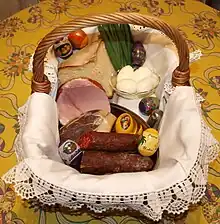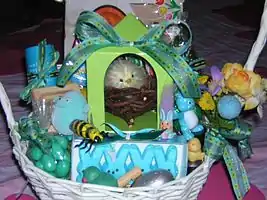
An Easter basket, also known as a Paschal basket,[1] is traditionally, a basket containing the foods traditionally forbidden to consume during Lent (meat, eggs, and dairy products), that is blessed by a priest for breaking the Lenten fast. This continues to be normative in Eastern Christianity and Easter baskets are typically blessed before the midnight service on Holy Saturday, with their contents being consumed at the feast after the service.[2]
In parts Western Christianity, emphasis is placed on making a Lenten sacrifice (giving up pleasures such as chocolate and cookies) rather than the traditional abstinence from meat, dairy products, and wine (though a few congregations have revived this practice);[upper-alpha 1][5] as such, in countries of the Western world such as the United States, Easter baskets are filled with Easter eggs and sweets after having abstained from them during Lent.[6][7]
Traditional

Traditions for Easter in Eastern European countries often includes blessing of baskets.[8][9][10][11][12][13]
Western Christianity
Poland
In Poland, Święconka or "the blessing of the Easter baskets" is a central tradition on Holy Saturday. [14] The tradition dates back to the 13-14th century in its earliest form.[15] The basket is traditionally lined with a white linen or lace napkin and decorated with sprigs of boxwood (bukszpan), the typical Easter evergreen. Baskets containing a sampling of Easter foods are brought to church to be blessed on Holy Saturday. After the blessing, the baskets of food are then set aside until Easter morning.[14]
Modern innovations
United States

Congregations and synods belonging to the Evangelical Lutheran Church in America, have made Easter baskets to be given to needy children or elderly persons.[16][17] These have been filled with Easter eggs, candy, and toys.[16]
An Easter tradition involves the Easter Bunny dropping off a gift basket of candy for good children overnight. Children leave a basket out overnight which the Easter bunny fills with candy, toys, and gifts on the night before Easter, and children wake up to find their Easter basket. Easter baskets are also used in Easter egg hunts, in which children try filling their basket with Easter eggs. [18]
References
Notes
- ↑ In Western Christianity, certain congregations from various traditions such as Roman Catholic, Methodist and Baptist, have committed themselves to undertaking the Daniel Fast, which enjoins fasting from meat, dairy products, and wine.[3][4]
Citations
- ↑ "About Paschal Baskets". St. Anthony of the Desert Orthodox Christian Mission. 10 May 2013. Archived from the original on 17 April 2022. Retrieved 14 April 2022.
- ↑ Encyclopedia of Religion. Macmillan Reference. 2005. p. 2399. ISBN 978-0-02-865740-0.
Eastern Christian families continue their tradition of creating intricately decorated Easter eggs to be included in a basket of foods (with sausage, butter, cakes, and other foods proscribed during Lent), which is taken to the church and blessed at the all-night Easter service and eaten at a holy breakfast following that service on Easter morning.
- ↑ "Lent: Daniel Fast Gains Popularity". HuffPost. Religion News Service. February 7, 2013. Retrieved December 30, 2018.
In some cases, entire churches do the Daniel Fast together during Lent. The idea strikes a chord in Methodist traditions, which trace their heritage to John Wesley, a proponent of fasting. Leaders in the African Methodist Episcopal Church have urged churchgoers to do the Daniel Fast together, and congregations from Washington to Pennsylvania and Maryland have joined in.
- ↑ Hinton, Carla (20 February 2016). "The Fast and the Faithful: Catholic parish in Oklahoma takes up Lenten discipline based on biblical Daniel's diet". The Oklahoman. Retrieved 27 March 2022.
Many parishioners at St. Philip Neri are participating in the Daniel fast, a religious diet program based on the fasting experiences of the Old Testament prophet Daniel. ... participating parishioners started the fast Ash Wednesday (Feb. 10) and will continue through Holy Saturday, the day before Easter Sunday.
- ↑ Crump, William D. (22 February 2021). Encyclopedia of Easter Celebrations Worldwide. McFarland. p. 157. ISBN 978-1-4766-4196-6.
During Lent, it is customary to abstain from ("give up") certain luxuries or vices as a symbolic sacrifice and devote the spare time to prayer, one's family, or other good works that draw one closer to Christ.
- ↑ Shoda, Richard W. (2014). Saint Alphonsus: Capuchins, Closures, and Continuity (1956-2011). Dorrance Publishing. p. 128. ISBN 978-1-4349-2948-8.
- ↑ "The History of Easter Traditions Around The World". The New York Carbib News. 14 April 2022. Retrieved 14 April 2022.
Real hard-boiled eggs, which are typically dyed or painted, artificial eggs made of plastic filled with chocolate or candies, or foil-wrapped egg-shaped chocolates of various sizes are hidden in various places; as many people give up sweets as their Lenten sacrifice, individuals consume them after having abstained from them during the preceding forty days of Lent.
- ↑ "What Goes into a Food Basket That is to be Blessed for Easter".
- ↑ "Byzantine Easter Traditions the Blessing of Easter Foods". 30 December 2015.
- ↑ "St. Louis Byzantine Catholic Mission".
- ↑ "Blessed baskets: Easter tradition in Valley endures despite pandemic".
- ↑ "Easter Sunday - How Byzantine Catholics Celebrate - TheByzantineLife". 29 March 2018.
- ↑ "Symbolism of the Foods in a Blessed Eastern European Easter Basket".
- 1 2 "The Treasured Polish Custom of Swieconka". Polish American Cultural Center. Retrieved 10 April 2016.
- ↑ Ks, Marian Pisarzak MIC. Błogosławienie pokarmów wielkanocnych. Kontekst paschalny i postny. op. cit. Błogosławieństwo pokarmów i napojów wielkanocnych w Polsce. Studium historyczno-liturgiczne. Warsaw 1979, p. 378. [przypisy tamże]
- 1 2 "Lutheran Social Services of Nevada is collecting Easter baskets". Grand Canyon Synod of the Evangelical Lutheran Church in America. 3 April 2019. Retrieved 14 April 2022.
- ↑ "Local church makes 70 Easter baskets for a nursing home". FOX13 News Memphis. 13 April 2022. Retrieved 14 April 2022.
- ↑ Coleman, Marilyn J.; Ganong, Lawrence H. (2014). The Social History of the American Family: An Encyclopedia. SAGE Publications.